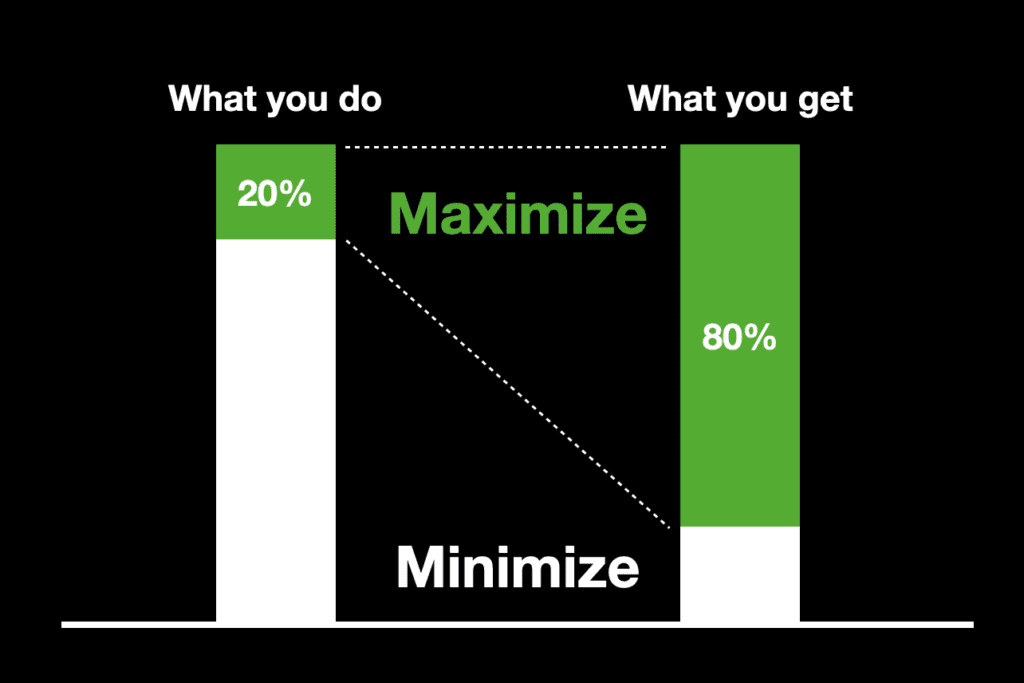
HOW TO USE THE 80/20 RULE TO MAXIMIZE (AND MINIMIZE) YOUR LIFE
Successful people maximize those activities that drive the most value, and minimize everything else. This post explains why the 80/20 rule is so powerful and gives five strategies to help you maximize…and minimize your life.

In our last podcast we talk about the 80/20 Rule. You can listen below or subscribe to your favorite podcast player. The 80/20 Rule is one of those simple observations that you intuitively understand, but often don’t fully appreciate.
Here’s the obligatory history, in literally 3 sentences. An Italian economist, Vilfredo Pareto, discovered that 20% of Italians owned 80% of the wealth. He thought this was interesting and started looking for similar relationships in other areas. He found many and over time the Pareto Principle, as the 80/20 Rule is also called, has come to signify the skewed relationship between inputs and outputs.
Whew. That wasn’t as bad as I thought. Now let’s briefly cover what the 80/20 rule really means.
Generally speaking, cause and effect are almost never proportional. A small number of causes create a large percentage of our effects. Many areas follow an 80/20 distribution, in which 20% of the causes result in 80% of the results. Some examples include:
-
20% of customers account for 80% of revenues
-
20% of dishes account for 80% of restaurant orders
-
20% of workers produce 80% of a company’s output
-
20% of our friends generate 80% of our positive memories
-
20% of product features account for 80% of usage
The numbers don’t have to be 80/20. The two numbers are not directly connected and they don’t have to equal 100. For example, it might be the case that 20% of the people have 80% of the wealth in a city, but in Warren Buffett’s neighborhood, it’s more like 99.9999999/20.
80/20 IS ABOUT MAXIMIZING AND MINIMIZING
The same rule follows for other aspects of our lives:
-
20% of our time studying accounts for 80% of what we learn
-
20% of our mistakes lead to 80% of our problems
-
20% of our workouts drive 80% of our exercise benefits
-
20% of what we do creates 80% of our future opportunities
Again, the numbers aren’t so important as the idea. Some activities are far more important to our desired outcomes than others.
If a small number of our actions create a large percentage of our results, then we should not treat all these behaviors the same way. We should put more focus on the important ones and maximize them. And conversely we should put less focus on the less important ones and minimize them.
Successful people do this very well. They put their energies into the activities that drive the most value, and they de-emphasize those activities that don’t result in a significant return. In some cases, that means they delegate them to someone else. In other cases that means they simply don’t do them at all.

MAXIMIZE THE TOP 20%
The first step is always figuring out what the most important 20% is. Once you’ve identified that, you want to put as much energy into those activities as possible. You want do them as effectively and as efficiently as possible.
If you are in business, these are the activities that drive the most revenues, the highest lead generation, or reduced the most costs.
If you are in school, these are studying the most important subjects, finding the best study environment in which to do it, and studying purposefully.
If you are an athlete, this means focusing your energy on the practice skills that will drive the majority of your success. And it means practicing those skills with the concentration and focus that will allow you to truly develop them.
Another great example of an 80/20 approach to personal development is adopting a mindset of developing Multiplier Skills that can be utilized in numerous different situation. When you develop a skill that can be used universally, you get more bang for your buck. You set yourself up for success now and you create future opportunities at the same time.
MINIMIZE THE “REST OF 80%”
For all the other activities in your life, the results simply do not justify the time and energy. Now, this doesn’t mean you can simply ignore them or not do them. What it means is doing them really well will give you about the same results as doing them “well enough”.
If this is the case, then you need to find a way to minimize these activities. This means getting as much out of them as you can using the least amount of time and energy. You want to automate, streamline, and systematize them.
Let’s say calling potential leads is in your top 20%, and doing paperwork is in your “rest of 80%”. If that’s the case, you can’t get sucked into spending extra time or energy doing the paperwork. You need to develop a system that allows you to get that paperwork done “well enough”. Then you need to get it done and move on.
Or if you are an athlete, your practice time will certainly be in your top 20%. Something like brushing your teeth would not be. You don’t need to put extra energy into how well you brush your teeth. Define a good enough teeth brushing routine and just get it done.
FIVE MORE STRATEGIES
Here are a few more simple ways to employ the 80/20 rule to make progress on your biggest problems.
#1: FIVE OUTLINES

Imagine you’re about to write a blog post, or design a product, or work on a marketing plan. Instead of trying to sit down and get it done, try this approach. Divide the time you have into fifths and outline five different options.
If you are a writer, write five outlines or sketch out five ideas. If you are a designer, sketch out five different possibilities before deciding which to pursue. If you are targeting new customers, consider five different approaches at a very high level.
No, none of those individual options will be as complete as if you’d just focused on one. But you will often find you are close to 80% done with each idea once you have the outline, and you can simply fill in the details later.
(Fun fact: I did this with this blog post. I sketched out three different articles, spending 20 minutes on each. All three got roughly 80% done just by having an outline. When I chose to finish this one, I just had to fill in the details.).
#2: NEGATIVE 80/20

We often focus on the 20% of what we do that leads to the 80% of our results we want. But what if we flip it around? What if we focus on the 20% of what we do that leads to the 80% of results we DON’T want?
My student gave me an example that I thought was really clarifying. He said he thinks 5% of people in our lives create 90% of our stress. This feels right to me.
Let’s assume it’s directionally correct. We need to figure out how to optimize our time spent around those people. If we can’t remove them entirely from our lives, then we need to figure out how to reduce whatever stress they are generating. A small improvement in one of those relationships could result in a HUGE benefit to our lives.
#3: WARREN BUFFETT’S TOP 25 PRIORITIES LIST
I wrote about Warren Buffett’s advice for prioritizing what’s important here.
Here’s the gist of it. Write down the top 25 priorities you have in your career (or life). Take your time. Make sure you get them all.
Now, decide which are your top 5. You can only pick 5. If you’re not sure, pick a criteria and force yourself to make a choice.
Now, the other 20 that didn’t make the cut have just become your “Do Not Do List”. Commit to NOT WORK on these at all. Minimize them to the point of non-existence.
It’s ruthless, I know. But it works. Check out the article for more on how to actually do it.
#4: NEXT LEVEL 80/20

We can apply the 80/20 rule on itself, and continue to prioritize further. If we take those top 25 priorities from the previous example, we can use the 80/20 rule to isolate the most important five. But we could again look at those five and ask, “Which one is the most important (or valuable, or essential)?”
Or perhaps, of these top five, which one can I do with the least amount of effort? Which will really move the needle for me?
There’s a very good chance one of those activities will drive much more value than even the other four. If so, then we should aim to maximize that one, even if it comes at the expense of the others.
And when we start to analyze that one activity, we may find it contains sub-activities that can again be prioritized. This will need to end at some point but we can always ask the question.
Just asking the question will often be enough to act as a check on your priorities.
#5: EISENHOWER MATRIX AND 80/20

In my post about the Eisenhower Matrix I argued you can use that tool to prioritize like a President. Let’s assume you already know how important and urgent each task is.
The Do It bucket is your Next Level 80/20. It is so important you need to put your time and energy on that task now.
The Schedule It bucket is the rest of your Top 20%. It’s important, so you need to focus on it. Find the right time and give it the right amount of energy.
The Delegate It bucket is most of the “Rest of 80%”. Try to find someone else to do it, or systematize it and get it done with as little effort as possible.
The Eliminate It bucket is anything you know just doesn’t drive any value. Stop spending your time on these!
THE 80/20 RULE ON THESE STRATEGIES
I just gave you five ideas based on the 80/20 rule that you could try to apply today. Chances are, one of them struck you as more powerful, more valuable, or more interesting than the other four. There is probably one that you are excited to apply, whereas the other four may not move you. Or you may know immediately how to get value out of one of them whereas the others aren’t so clear.
The 80/20 rule applies here, too. Use it to decide which of the above strategies you’re going to do now.

BRYAN GREEN
Bryan Green is the co-founder, Editor, and COO of Go Be More. He sees the 80/20 rule wherever he looks. Oh look, there it is. Ooh, it’s over there, too. Do you see it?. Tell him where you see it at bryan@gobemore.co or on our Facebook page.


